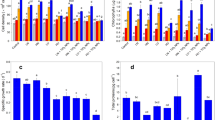Abstract
Nano-TiO2 is a widely applied nanoparticle (NPs) and co-exists with other pollutants such as heavy metals in aquatic environments. However, minimal knowledge is available concerning the ecological risk of these mixtures. Our study reported that at no toxic effect concentrations of TiO2 nanoparticles (5 mg/L), the toxicity of Cu ions to the algae Microcystis aeruginosa was significantly attenuated by TiO2 nanoparticles. Specifically, the concentration of photosynthetic pigments (i.e., concentration of Chla) increased 37 % when comparing only Cu ions treated and the nano-TiO2-Cu co-incubation. The levels of phycocyanin (PC), allophycocyanin (APC), phycoerythrin (PE), and phycobiliprotein (PBPs) were also recovered at levels ranging from 23 to 35 % after 72 h. For oxidative indexes, the decreased activities of the superoxide dismutase (SOD), peroxidase (POD) content, and malondialdehyde (MDA) with the existence of nano-TiO2 displayed a lower level compared to Cu ions treatment only at 24 and 48 h. This toxicity attenuation can be confirmed by subcellular structures because the impairment to cellular membranes and organelles reduced with the presence of nano-TiO2. The potential mechanisms of the antagonism between the nano-TiO2 and Cu ions can be partially attributed to the sorption of copper onto TiO2 nanoparticles, which fitted the Freundlich isotherm (coefficient = 0.967). The decreased bioavailability of Cu ions protected algae cells from being attacked by free Cu ions. Given the abundance of released nanoparticles and unique physicochemical property of nanoparticles, our results elucidated the ecosafety of nanoparticles and co-substrates in aquatic systems.






Similar content being viewed by others
References
Ballan-Dufranc-ais C, Marcaillou C, Amiard-Triquet C (1991) Response of the phytoplanktonic alga tetraselmis suecica to copper and silver exposure: vesicular metal bioaccumulation and lack of starch bodies. Biol Cell 72:103–112
Chen JY, Zhu DQ, Sun C (2007) Effect of heavy metals on the sorption of hydrophobic organic compounds to wood charcoal. Environ Sci Technol 41:2536–2541
Chen JY, Dong X, Xin YY, Zhao MR (2011) Effects of titanium dioxide nano-particles on growth and some histological parameters of zebrafish (Danio rerio) after a long-term exposure. Aquat Toxicol 101:493–499
EPA (The United States Environmental Protection Agency) (2007) Aquatic life ambient freshwater quality criteria-copper 2007 revision.EPA-822-R-07-001. <http://www.epa.gov/waterscience/criteria/copper/index.htm>
EPA (The United States Environmental Protection Agency) (2009) External review draft, nanomaterial case studies: nanoscale titanium dioxide in water treatment and in topical sunscreen. United States Environmental Protection Agency. <http://www.safenano.org/SingleNews.aspx? NewsId = 788 (accessed 09.10.10)>
Fan WH, Cui MM, Liu H, Wang C, Shi ZW, Tan C, Yang XP (2011) Nano-TiO2 enhances the toxicity of copper in natural water to Daphnia magna. Environ Pollut 159:729–734
Gaetke LM, Chow CK (2003) Copper toxicity, oxidative stress, and antioxidant nutrients. Toxicology 189:147–163
Griffitt RJ, Luo J, Gao J, Bonzongo JC, Barber DS (2008) Effects of particle composition and species on toxicity of metallic nanomaterials in aquatic organisms. Environ Toxicol Chem 27:1972–1978
Hall S, Bradley T, Moore JT, Kuykindall T, Minella L (2009) Acute and chronic toxicity ofnano-scale TiO2 particles to freshwater fish, cladocerans, and green algae, and effects of organic and inorganic substrate on TiO2 toxicity. Nanotoxicology 3:91–97
Hartmann NB, Von der Kammer F, Hofmann T, Baalousha M, Ottofuelling S, Baun A (2010) Algal testing of titanium dioxide nanoparticles-testing considerations, inhibitory effects and modification of cadmium bioavailability. Toxicology 269:190–197
Inskeep WP, Bloom PR (1985) Extinction coefficients of chlorophyll a and b in N, N-dimethylformamide and 80 % acetone. Plant Physiol 77:483–485
Kaegi R, Ulrich A, Sinnet B, Vonbank R, Wichser A, Zuleeg S, Simmler H, Brunner S, Vonmont H, Burkhardt M, Boller M (2008) Synthetic TiO2 nanoparticle emission from exterior facades into the aquatic environment. Environ Pollut 156:233–239
Karen EE, Heather JS (2011) Adsorption of Pb, Cd, Cu, Zn, and Ni to titanium dioxide nanoparticles: effect of particle size, solid concentration, and exhaustion. Environ Sci Pollut Res 18:386–395
Knauert S, Knauer K (2008) The role of reactive oxygen species in copper (Cu) toxicity to two freshwater green algal. J Phycol 44:311–319
Navarro E, Baun A, Behra R, Hartmann N, Filser J, Miao AJ, Quigg A, Santschi PH, Sigg L (2008) Environmental behavior and ecotoxicity of engineered nanoparticles to algae, plants, and fungi. Ecotoxicology 17:372–386
Nishikawa K, Yamakoshi Y, Uemura I, Tominaga N (2003) Ultrastructural changes in Chlamydomonas acidophila (Chlorophyta) induced by heavy metals and polyphosphate metabolism. Microb Ecol 44:253–259
Padgett MP, Krogmann DW (1987) Large scale preparation of pure hycobiliproteins. Photosynth Res 11:225–235
Qian HF, Chen W, Sheng GD, Xu XY, Liu WP, Fu ZW (2008) Effects of glufosinate on antioxidant enzymes, subcellular structure, and gene expression in the unicellular green alga Chlorella vulgaris. Aquat Toxicol 88:301–307
Qian HF, Li JJ, Sun LW, Chen W, Sheng GD, Liu WP, Fu ZW (2009) Combined effect of copper and cadmium on Chlorella vulgaris growth andphotosynthesis-related gene transcription. Aquat Toxicol 94:56–61
Qian HF, Yu SQ, Sun ZQ, Xie XC, Liu WP, Fu ZW (2010) Effects of copper sulfate, hydrogen peroxide and N-phenyl-2-naphthylamine on oxidative stress and the expression of genes involved photosynthesis and microcystin disposition in Microcystis aeruginosa. Aquat Toxicol 99:405–412
Wen YZ, Chen H, Shen CS, Zhao MR, Liu WP (2011) Enantioselectivity tuning of chiral herbicide dichlorprop by copper: roles of reactive oxygen species. Environ Sci Technol 45:4778–4784
Acknowledgments
This study is supported by the National Natural Science Foundation of China (No.21177114).
Author information
Authors and Affiliations
Corresponding author
Additional information
Responsible editor: Philippe Garrigues
Rights and permissions
About this article
Cite this article
Chen, J., Qian, Y., Li, H. et al. The reduced bioavailability of copper by nano-TiO2 attenuates the toxicity to Microcystis aeruginosa . Environ Sci Pollut Res 22, 12407–12414 (2015). https://doi.org/10.1007/s11356-015-4492-9
Received:
Accepted:
Published:
Issue Date:
DOI: https://doi.org/10.1007/s11356-015-4492-9




